
Killer Instinct is a 2.5D fighting game developed by Rare, published by Nintendo and manufactured by Midway. It was originally released for arcades in October 1994, and ported to the Super Nintendo Entertainment System and the Game Boy the following year. The game's plot involves an all-powerful corporation organizing a fighting tournament. The story was adapted in a limited comic book series published under the short-lived Acclaim Comics imprint.

Mortal Kombat 4 is a 1997 fighting game, the fourth main installment in the Mortal Kombat franchise, and a sequel to 1995's Mortal Kombat 3. It was developed by Midway Games. Released to arcades in 1997, Mortal Kombat 4 is the first title in the series, and one of the first made by Midway overall, to use 3D computer graphics. It is also the last game of the series to have an arcade release. It was ported to the PlayStation, Nintendo 64, PC, and Game Boy Color in 1998. An updated version titled Mortal Kombat Gold was released exclusively for the Dreamcast.
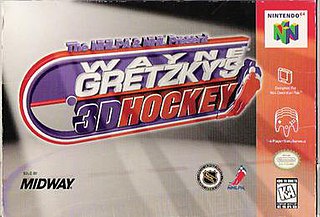
Wayne Gretzky's 3D Hockey is a video game developed and published by Atari Games for the arcade in 1996. A port for the Nintendo 64 console was released almost simultaneously with the arcade version, on November 15, 1996, making it the first-ever 4-player game for the Nintendo 64, beating Mario Kart's Japanese release by more than a month. The game was followed by a sequel, Wayne Gretzky's 3D Hockey '98.

Cruis'n USA is an arcade racing game originally released in 1994. It was developed by Eugene Jarvis' company TV Games Inc., and manufactured by Midway Games. It is the first game in the Cruis'n series and features races set in locations across the continental United States.
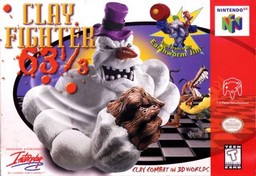
ClayFighter 63⅓ is a 1997 fighting game developed and published by Interplay Productions for the Nintendo 64. It is the third installment of the ClayFighter series. The title is a parody of the 64 suffix common with Nintendo 64 games.

Mortal Kombat 3 is a 1995 arcade fighting game developed by Midway Games. It is the third main installment in the Mortal Kombat franchise and a sequel to 1993's Mortal Kombat II. As in the previous games, it has a cast of characters that players choose from and guide through a series of battles against other opponents. The game avoids the tournament storyline of its predecessors, as various warriors instead fight against the returning Shao Kahn, who has resurrected his bride Sindel and started an invasion of Earthrealm.

Mortal Kombat Trilogy is a fighting game released by Midway in 1996 as the second and final update to Mortal Kombat 3 for the PlayStation, Nintendo 64, Sega Saturn and PCs. Further versions were also released for the Game.com and R-Zone. It features a similar basic gameplay system and the same story as Ultimate Mortal Kombat 3, but adds characters and stages restored from Mortal Kombat and Mortal Kombat II. New additions to the game included the "Aggressor" bar. The Brutality mechanic was introduced with this installment. The game was met with positive to mixed reviews upon release.

Primal Rage is a fighting game developed and released by Atari Games for arcades in 1994. The game takes place on a post-apocalyptic version of Earth called "Urth". Players control one of seven prehistoric beasts, that battle each other to determine the planet's fate. Matches feature many of the conventions of fighting games from the era, including special moves and gory finishing maneuvers. Ports were released for home video game consoles and personal computers. Efforts to perfectly emulate the arcade original have been unsuccessful due to the use of an unusual copy protection method. Toys, comics, a novel and other merchandise tie-ins were produced. More than 1.5 million copies of the game were sold.

Ultimate Mortal Kombat 3 is a fighting game in the Mortal Kombat series, developed and released by Midway to arcades in 1995. It is a standalone update of 1995's earlier Mortal Kombat 3 with an altered gameplay system, additional characters like the returning favorites Reptile, Kitana, Jade and Scorpion who were missing from Mortal Kombat 3, and some new features.

Mortal Kombat Mythologies: Sub-Zero is a 1997 action-adventure game developed and published by Midway for the PlayStation and Nintendo 64. A spin-off of the Mortal Kombat franchise, it is the first installment to not be a fighting game. Set before the original 1992 game, players control Bi-Han, the elder Sub-Zero, during his quest to find Shinnok's amulet. It also serves as a prequel to Mortal Kombat 4, which was released the same year, introducing characters and story elements that would be used by the fourth main installment. Mythologies is the final game in the series to use digitized actors.
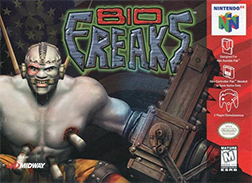
Bio F.R.E.A.K.S. is a 3D fighting video game released by Midway in 1998. It was originally planned for arcades. Prototypes of the game were tested at arcades, but the final arcade release was canceled and the game was later released for the PlayStation, Nintendo 64 and Microsoft Windows.
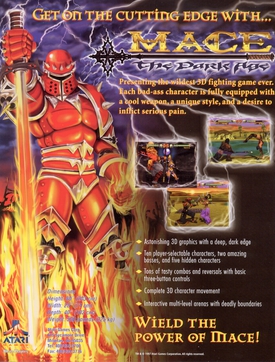
Mace: The Dark Age is a fighting video game released by Atari Games for arcade machines in 1997 and later ported by Midway Games to the Nintendo 64. Like many fighting games of the time, its style is marked by extreme violence, with characters graphically slaying defeated opponents. Utilizing 3dfx Voodoo chips for the hardware, the game received attention for its cutting-edge graphics and turned Atari a profit in the arcades. Critical response to the gameplay was much less enthusiastic.

Dark Rift is a 3D fighting video game for the Nintendo 64, notable for being the first N64 game to use 60 frames per second. It has been referred to as the Nintendo 64's first native fighting game, though in actuality it started development as a Sega Saturn game. In addition, it was originally announced that the Microsoft Windows version of the game would precede the Nintendo 64 version by one month.

Aero Fighters Assault is an arcade-style combat flight simulator developed by Paradigm Entertainment and published by Vic Tokai and Video System for the Nintendo 64 in 1997.

California Speed is a racing video game developed and published by Atari Games. The game was first released in arcades in 1998 and was ported to the Nintendo 64 in 1999 by Midway. The Nintendo 64 version of the game contains support for the Controller Pak and the Rumble Pak.

G.A.S.P!! Fighters' NEXTream is a fighting video game for the Nintendo 64 released in 1998. The story follows a series of fighters that have each received a mysterious letter to compete in a legendary contest, and about a champion that has disappeared. The North American versions are known as Deadly Arts. The story and the player profiles do not appear in the instructions for the North American version. Except for the title, it is basically the same as the Japan and Europe versions, with slightly changed voice messages, and different character nameplates.

NBA Hangtime is a 1996 basketball arcade game developed and released by Midway. Home versions were released for the Nintendo 64, PlayStation, Super NES, Sega Genesis, and Microsoft Windows.
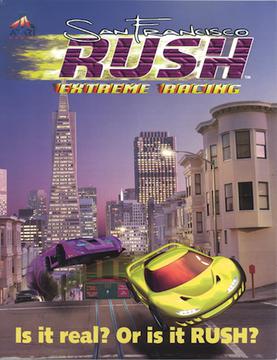
San Francisco Rush: Extreme Racing is a video game developed and published by Atari Games. This game was first released in arcades in 1996 and was ported to Nintendo 64 in 1997 and the PlayStation in 1998. San Francisco Rush: Extreme Racing is the first game in the Rush series.

Killer Instinct Gold is a fighting game based on the arcade game Killer Instinct 2. The game was developed by Rare and released by Nintendo for the Nintendo 64. Players control characters who fight on a 2D plane set against a 3D background. Players press buttons to punch and kick their opponent in chains of successive hits, known as combos. Large combo successions lead to stronger attacks and brutal, stylistic finisher moves underscored by an announcer. Characters—including a gargoyle, a ninja, and a femme fatale—fight in settings such as a jungle and a spaceship. Killer Instinct Gold includes the arcade release's characters, combos, and 3D, pre-rendered environments, but excludes its full-motion video sequences and some voice-overs due to restrictions of the cartridge media format. The Gold release adds a training mode, camera views, and improved audiovisuals.

NFL Blitz is an American football video game developed and published by Midway for the arcade in 1997, the first game in the NFL Blitz series. The development team was headed by Mark Turmell and Sal Divita, who were known for being behind NBA Jam, and NFL Blitz was a deliberate attempt to translate the exaggerated arcade-style approach of NBA Jam to the football realm. The game was ported to the PlayStation, Nintendo 64, Windows, and Game Boy Color in 1998. The cover athlete for the game was then Pittsburgh Steelers quarterback Kordell Stewart.




















